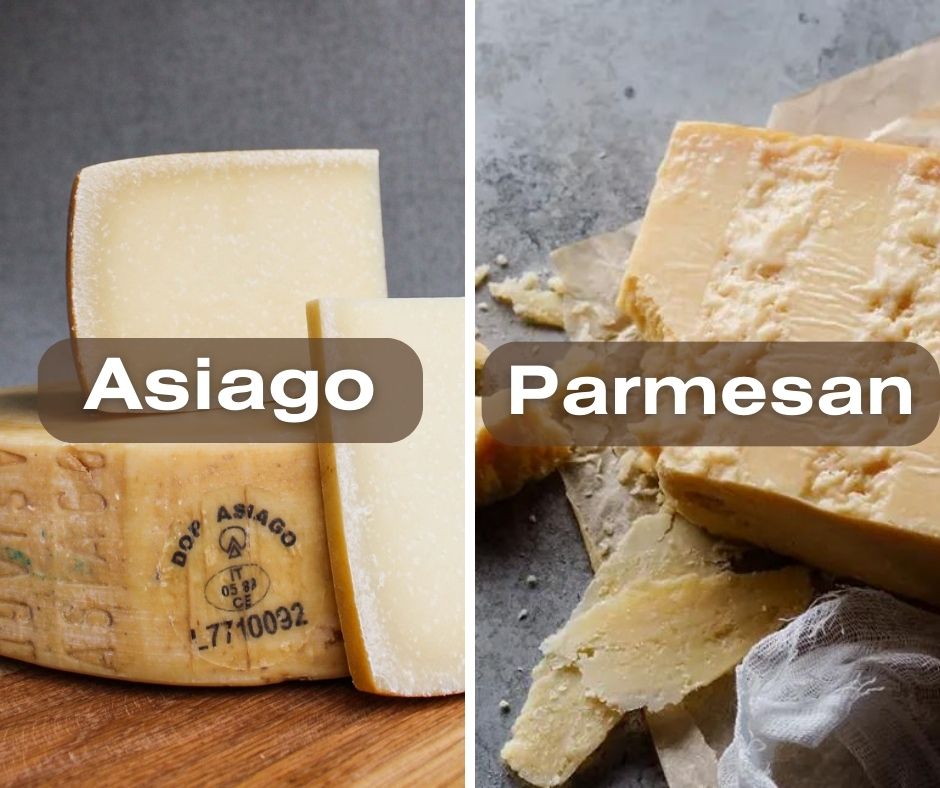Last Updated on September 3, 2023 by Aaron
Asiago and Parmesan are both renowned Italian cheeses with distinct characteristics. Asiago, originating from the Veneto region, varies in texture and flavor based on its aging: fresh Asiago is soft with a mild taste, while aged Asiago is hard and tangy.
Parmesan, hailing from the Emilia-Romagna region, consistently offers a hard, grainy texture with a rich, nutty flavor intensified by its long aging process, often making it pricier.
Both cheeses have been victim to inauthentic copies, especially in regions outside of Europe. “Parmesan” in particular has been used as a generic term for hard, grating cheese in some places, further blurring the lines between authentic Parmigiano-Reggiano and other similar cheeses like Asiago.
This table provides an at-a-glance comparison between the two cheeses:
| Asiago | Parmesan | |
| Origin | Veneto region, Northern Italy | Emilia-Romagna region, Italy |
| Texture | – Fresh (Asiago Pressato): Soft and smooth – Aged (Asiago d’Allevo): Hard and crumbly | Hard, grainy, and crumbly |
| Flavor | – Fresh: Mild and delicate – Aged: Sharp and tangy | Rich, nutty, and sharp |
| Aging | – Fresh: 20-40 days – Aged: Several months to over two years | Minimum of 12 months, often 24-36 months or more |
| Primary Uses | Fresh: Table cheese, sandwiches Aged: Grated over dishes, salads, and pastas | Grating cheese for pastas, risottos, salads, and standalone slivers |
| Appearance | Pale yellow | Light golden hue |
| Cost | Typically more affordable | Often pricier due to long aging and strict production standards |
Table of Contents
Flavor Profile
Asiago cheese, originating from Northern Italy, presents a varied flavor profile based on its age.
Fresh Asiago, or Asiago Pressato, which is aged for 20-40 days, offers a creamy, mild, and slightly tangy taste, embodying the essence of fresh milk. On the other hand, Aged Asiago, known as Asiago d’Allevo, matures over several months to over two years. Its flavor deepens with time, transitioning from a semi-sweet and nutty nuance in moderately aged versions to a pronounced sharp, tangy, and at times slightly bitter taste in those aged longer.
Moving south to the Emilia-Romagna region, Parmesan or Parmigiano-Reggiano showcases its flavor evolution prominently. Young Parmesan, aged around 12 months, exhibits a creamy, rich, and somewhat fruity flavor, maintaining a softer texture that retains some milkiness. As the cheese ages to the 24-month mark and beyond, it becomes what many consider mature. Mature Parmesan boasts a more intense, savory, and nutty flavor, and is often accompanied by an umami taste. The texture evolves, too, growing more crystalline and giving the cheese a distinct richness.
Additionally, there’s the commonly available regular Parmesan (maybe aged as little as 10 months) often found pre-grated in shaker containers. This type tends to be milder, often saltier, and lacks the depth and complexity inherent in traditionally aged Italian Parmesan.
Can you Substitute Parmesan with Asiago?
Yes, you can absolutely substitute Parmesan with Asiago (or vice versa). Both Parmesan and Asiago are Italian hard cheeses with a crumbly texture and rich taste. They’re often used in grating over pasta, salads, and soups or in recipes for a distinctive flavor.
As mentioned above, Parmesan has a distinct, strong, nutty flavor, while Asiago can be milder overall and more on the creamy, delicate side of the spectrum, especially if it’s a younger version of the cheese. Aged Asiago (Asiago d’allevo) has a stronger, sharper taste more reminiscent of aged Parmesan. If you’re substituting for Parmesan, it’s a good idea to use the aged variety of Asiago.
For grating over pasta, salads, or soups, aged Asiago can work as a 1-to-1 ratio substitute for Parmesan without dramatically altering the outcome. For cooking applications such as sauces or fillings, do note that both cheeses melt, but they do so differently. Parmesan doesn’t become gooey like mozzarella; it softens more than it melts. Asiago, especially the younger version, can melt more uniformly. Additionally, Parmesan is usually saltier than Asiago.
If you don’t have Asiago or Parmesan, other hard Italian cheeses such as Pecorino Romano or Grana Padano can be good alternatives. However, Pecorino Romano is made from sheep’s milk and tends to be much saltier than Parmesan. Read more in our previous post of Asiago vs. Pecorino.
Key Differences in Uses
Fresh Asiago can be melted more readily than Parmesan, making it suitable for dishes where a melty consistency is desired. For example, it can be used in sandwiches, salads, or even melted on pizzas and in casseroles. For the aged version, it’s commonly grated and used similarly to Parmesan over pasta, risottos, and salads. It can also be enjoyed on its own, paired with wine, fruits, or charcuterie.
Parmesan tends to have a stronger, more pronounced flavor than even aged Asiago, so dishes that rely heavily on the flavor of the cheese (like a simple pasta with butter and cheese) might be noticeably different when substituting one for the other. For instance, It can be incorporated into various dishes, like alfredo sauce, stuffed pastas, and meatballs, to add depth of flavor.
The rind of Asiago can sometimes appear thinner than that of Parmesan, especially in relation to the size and age of the cheese. You can use the rind pretty much like parmesan rind for various soups, broths, sauces, or stews dishes.


